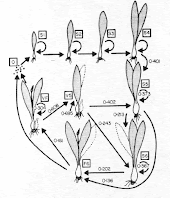A few years ago I made a cross between a sunflower (var. "Russian Mammoth") and a sunchoke (probably var. "Stampede"). My goal was to eventually get a plant that produced tubers like the sunchoke, but was super-charged with the giant growth of the sunflower. The two species have different chromosome counts, which complicates things a bit.
That first cross resulted in three F1 plants. I should have grown more, but it didn't work out that way. One of the plants grew to 10ft tall, with relatively large flowers, while the other two looked more or less like the sunchoke parent. I moved by the end of this season, but I was able to go back and recover root material from the plants. I then stored the roots in a fridge over the first winter and planted them at our new place when spring came around. Only the tubers produced from the largest plant survived this process.
Our current place has routine visitations by deer who seem to find sunflower leaves delectable. The first several shoots produced by the tubers were neatly trimmed to the ground. When I finally put together some protection for them, they succeeded in sending up one final shoot. That shoot topped out at about 2ft tall and produced a single small flower. This was a far-cry from the 10ft skyscraper the tuber had come from. I was so disappointed that I didn't even take any pictures of the little plant. I assumed the repeated early-season trimmings had dwarfed it and hoped it would do better the following year.
I was better prepared for 2016. I made a 7ft tall chicken-wire cylinder to place around the growing plant. This kept the plant protected for most of the season. The cylinder was knocked over a couple times (either by storms or aggressive deer), but this only exposed the lower leaves to the hungry mammals. The plant grew to about as tall as the cage and bloomed, still well short of the 10 ft of the first year. Though the plant branched much more than the first year, it did so much less than the sunchoke parent.
I'm hoping the plant will do even better in 2017. Three clusters of new shoots have been coming up near where the plant was last year and I have a slightly wider protective cage put in place. The shoots are more widely spaced than they were last year. I'm hoping this means each individual stem will be larger/taller.
The plant produced abundant seeds in the first year, but has since then produced absolutely none. I'm pretty sure this means the plant inherited the self-incompatibility mechanism from its sunchoke mother. The first year there was plenty of pollen from its siblings, but there has been none the last couple of years.
There may be a few oilseed sunflowers around this year to contribute pollen, grown from scattered birdseed. My perennial sunflower is tetraploid, so any crosses to these diploids would produce highly sterile triploid offspring. These might be interesting to grow, but they wouldn't contribute to my overall goal.
For my breeding goals to move forward, I'll need to produce more tetraploid F1s by crossing sunchoke and another giant sunflower. I don't have any sunchoke planted right now, so I probably won't be able to get flowers even if I did find some tubers soon. There are several giant sunflower varieties I could use to help make more F1s, but I'll probably keep using "Russian Mammoth" to simplify the overall genetics of the future F2s.
References:
 |
| 2014 |
Our current place has routine visitations by deer who seem to find sunflower leaves delectable. The first several shoots produced by the tubers were neatly trimmed to the ground. When I finally put together some protection for them, they succeeded in sending up one final shoot. That shoot topped out at about 2ft tall and produced a single small flower. This was a far-cry from the 10ft skyscraper the tuber had come from. I was so disappointed that I didn't even take any pictures of the little plant. I assumed the repeated early-season trimmings had dwarfed it and hoped it would do better the following year.
 |
| 2016 |
Our new yard has lots of animal traffic besides the deer. Turkeys are commonly seen in the neighborhood, though we don't often see them in our yard.
 |
| 2017 |
The plant produced abundant seeds in the first year, but has since then produced absolutely none. I'm pretty sure this means the plant inherited the self-incompatibility mechanism from its sunchoke mother. The first year there was plenty of pollen from its siblings, but there has been none the last couple of years.
There may be a few oilseed sunflowers around this year to contribute pollen, grown from scattered birdseed. My perennial sunflower is tetraploid, so any crosses to these diploids would produce highly sterile triploid offspring. These might be interesting to grow, but they wouldn't contribute to my overall goal.
For my breeding goals to move forward, I'll need to produce more tetraploid F1s by crossing sunchoke and another giant sunflower. I don't have any sunchoke planted right now, so I probably won't be able to get flowers even if I did find some tubers soon. There are several giant sunflower varieties I could use to help make more F1s, but I'll probably keep using "Russian Mammoth" to simplify the overall genetics of the future F2s.
References:
- Earlier blog posts on sunflowers:
- Background info on this cross:

